Related Research Articles

Stillwater is the tenth-largest city in the U.S. state of Oklahoma. It is the county seat of Payne County, Oklahoma. It is located in north-central Oklahoma at the intersection of U.S. Route 177 and State Highway 51. As of the 2020 census, the city population was 48,394. The Stillwater Micropolitan Statistical Area had a population of 78,399 according to the 2012 census estimate. Stillwater was part of the first Oklahoma Land Run held on April 22, 1889, when the Unassigned Lands were opened for settlement and became the core of the new Oklahoma Territory. The city charter was adopted on August 24, 1889, and operates under a council-manager government system.

Mary Elizabeth Price, also known as M. Elizabeth Price, was an American Impressionist painter. She was an early member of the Philadelphia Ten, organizing several of the group's exhibitions. She steadily exhibited her works with the Pennsylvania Academy of the Fine Arts, the National Academy of Design, and other organizations over the course of her career. She was one of the several family members who entered the field of art as artists, dealers, or framemakers.
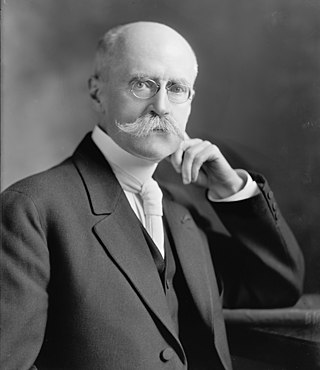
Edwin Howland Blashfield was an American painter and muralist, most known for painting the murals on the dome of the Library of Congress Main Reading Room in Washington, DC.

Olive Rush was a painter, illustrator, muralist, and an important pioneer in Native American art education. Her paintings are held in a number of private collections and museums, including: the Brooklyn Museum of New York City, the Haan Mansion Museum of Indiana Art, the Indianapolis Museum of Art, Indiana and the Smithsonian American Art Museum.
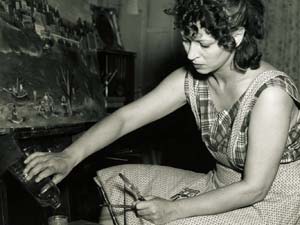
Doris Emrick Lee was an American painter known for her figurative painting and printmaking. She won the Logan Medal of the Arts from the Chicago Art Institute in 1935. She is known as one of the most successful female artists of the Depression era in the United States.

The Henry Clay Frick Fine Arts Building is a landmark Renaissance villa and a contributing property to the Schenley Farms-Oakland Civic Historic District on the campus of the University of Pittsburgh in Pittsburgh, Pennsylvania, United States. The Frick Fine Arts Building sits on the southern edge of Schenley Plaza, opposite The Carnegie Institute, and is the home of Pitt's History of Art and Architecture Department, Studio Arts Department, and the Frick Fine Arts Library. Before its front steps is Mary Schenley Memorial Fountain.

The Treasury Section of Painting and Sculpture was a New Deal art project established on October 16, 1934, and administered by the Procurement Division of the United States Department of the Treasury.

Henry Varnum Poor was an American architect, painter, sculptor, muralist, and potter. He was a grandnephew of the Henry Varnum Poor who was a founder of the predecessor firm to Standard & Poor's.

United States post office murals are notable examples of New Deal art produced during the years 1934–1943.
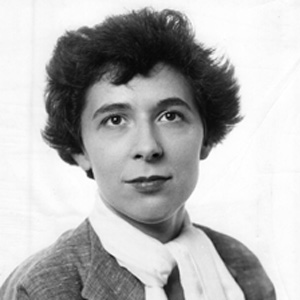
Martyl Suzanne Schweig Langsdorf was an American artist who created the Doomsday Clock image for the June 1947 cover of the Bulletin of the Atomic Scientists.
Frances Foy was an American painter, muralist, illustrator, and etcher born in Chicago, Illinois.

Musa Jane McKim Guston, was a painter and poet. Born in Oil City, Pennsylvania, McKim spent much of her youth in Panama. During the Great Depression, she worked under the Section of Fine Arts, painting murals in public buildings, including a Post Office building in Waverly, New York. She was the wife of New York School artist Philip Guston, whom she met while attending the Otis Art Institute. In cooperation with him, she painted a mural in a United States Forest Service building in Laconia, New Hampshire, and panels which were placed aboard United States Maritime Commission ships. After her painting career, she wrote poetry, publishing her work in small literary magazines. Along with her husband and daughter, she lived in Iowa City, Iowa and New York City, eventually settling in Woodstock, New York. Her younger sister was Olympic swimmer Josephine McKim (1910-1992).

Miriam McKinnie also known as Miriam McKinnie Hofmeier, was an American artist.
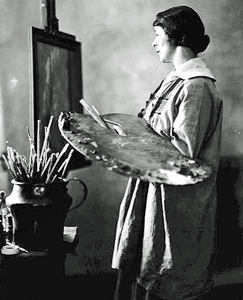
Elsa Laubach Jemne (1887–1974) was an American landscape painter, portraitist, muralist and illustrator born in St. Paul, Minnesota. She attended the St. Paul Institute before continuing her art studies at the Pennsylvania Academy of Fine Arts in Philadelphia.
Sandy Kessler Kaminski is an American painter and mixed-media artist who is also known for her public art murals. She currently lives in Pittsburgh, Pennsylvania, where her work can be found in many places throughout the city and the surrounding area.

Ryah Ludins (1896–1957) was a Ukrainian-born American muralist, painter, printmaker, art teacher, and writer. She made murals for post offices and other government buildings during the Great Depression and also obtained commissions for murals from Mexican authorities and an industrial concern. Unusually versatile in her technique, she made murals in fresco, mixed media, and wood relief, as well as on canvas and dry plaster. She exhibited her paintings widely but became better known as a printmaker after prints such as "Cassis" (1928) and "Bombing" drew favorable notice from critics. She taught art in academic settings and privately, wrote and illustrated a children's book, and contributed an article to a radical left-wing art magazine. A career spanning more than three decades ended when she succumbed to a long illness in the late 1950s.
Olive Nuhfer (1901-1996) was an American painter. She is best known for her New Deal era mural in the Westerville, Ohio Post Office.
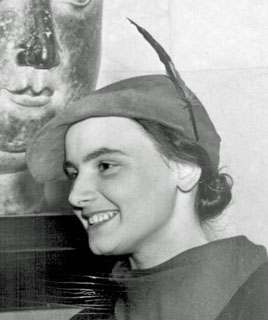
Elizabeth Carney Pope (1910–1991) was an American painter. Pope used a variety of names during her career including Elizabeth Jeanette Carney, Betty Carney, Elizabeth Carney, and Betty Carney Pope. She is best known for her New Deal era mural in the Chisholm, Minnesota Post Office.

John Ward Lockwood was an American painter, art teacher and veteran of two world wars.
References
- ↑ "Grace Hamilton - Biography". AskArt. Retrieved March 9, 2022.
- 1 2 "Grace Hamilton: History of Payne County - Educator's Resource". OSU Museum of Art. August 9, 2016. Retrieved March 9, 2022.
- ↑ "Lysinger-Hamilton, The Pittsburgh Press, (Pittsburgh, Pennsylvania) June 26, 1920, p 3". The Pittsburgh Press. June 26, 1920. p. 3. Retrieved March 9, 2022.
- ↑ United States Commission of FineArts (1965). Report. U.S. Government Printing Office. p. 52.
- ↑ "Designing the Museum: The Postal Plaza Mural". Oklahoma State University Art Collection. January 24, 2011. Retrieved March 9, 2022.
- ↑ "Grace Lysinger Hamilton (1894-1992)". Find a Grave. Retrieved March 9, 2022.